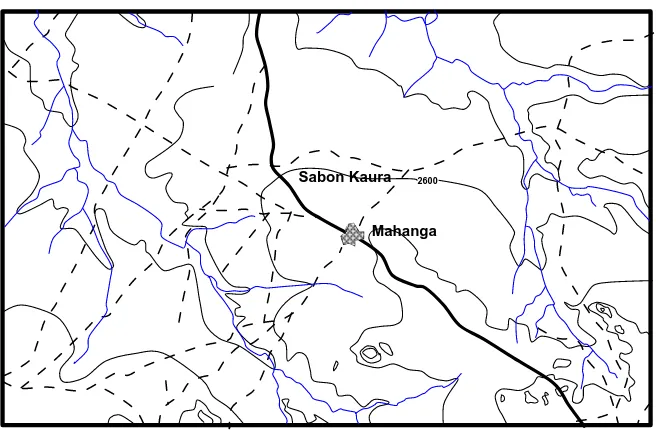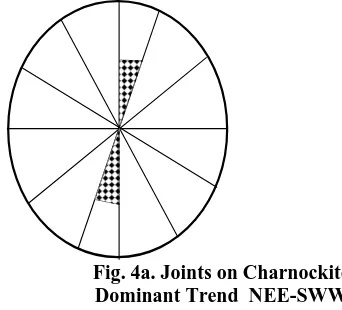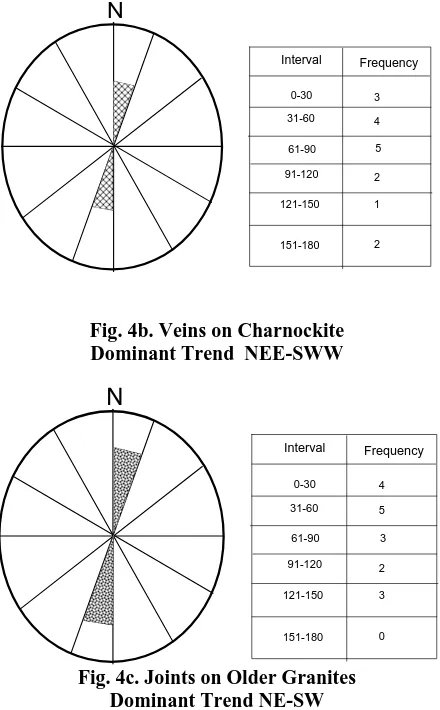The Dimension-Stone Potentials of The Rocks In
Mahanga, North Central Nigeria
Joyce Ayuba Ramadan*, Mamuda Isiaka**, John Pam Chongs**
*
Department of Minerals & Petroleum Resources, Plateau State Polytechnic, P.M.B 02023, Barkin Ladi. **
Department of Minerals & Petroleum Resources, Plateau State Polytechnic, P.M.B 02023, Barkin Ladi. **
Department of Minerals & Petroleum Resources, Plateau State Polytechnic, P.M.B 02023, Barkin Ladi.
Abstract- Dimension stone can also be defined as any rock that has been removed from its natural place of origin for ultimate use in construction or monuments where three dimensions of size together with shape and other elements of appearance, such as colour, grain texture and pattern and surface finish, are normal requirements; it is usually quarried for the purpose of obtaining blocks or slabs that meet specification of size and shape. The availability of Porphyritic Older Granites and Charnokite rocks within the study area in abundance stimulated the examination of the rock samples in various capacities to ascertain their suitability for the purpose of dimension stone quarry. The structural disposition of these rock types were observed, recorded and analysed which reveal a general orientation in the NE-SW directions concurring with the regional structural trend of the area as well as the mineral compositions. In addition, the structures were well spaced in such a way as to optimize block exploitation. Physical properties, such as strength, porosity estimation, aesthetic value test and oxidation tests were carried out on fresh samples. The results displayed satisfactory abilities to be quarried as dimension stones which could be cut, trimmed and polished for tiles and block production or even used without polish.
Index Terms- Dimension stones, Quarry, Rocks, Granites,
Charnockites
I. INTRODUCTION
he study area forms part of Ririwai sheet 126 SW, it is located in Lere Local Government Area (LGA) of Kaduna state. It is underlain by rocks of the Crystalline Basement which is indicative of the several episodes of deformation specifically the Pan African orogeny.
Dimension stone is a natural stone or rock that has been selected and fabricated (trimmed, cut, drilled, ground) to specific sizes or shapes[1]. Colour, texture, pattern, and surface finish of the stone are normal requirements. Another important selection criterion is durability, the time measure of the ability of dimension stone to endure and to maintain its essential and distinctive characteristics of strength, resistance to decay, and appearance. Natural stones are sophisticated materials that add dimension and style to architecture and structural designs. Highly polished to rustic, natural stones can add a creative element that embodies the essence of traditionalism to the most contemporary designs[2]. Most of the developed countries like Italy, Spain, Germany, Brazil, China etc engage in large scale
exploitation of natural rocks for the production of polished products like slabs, blocks and tiles. In addition to aesthetic beauty, the glossy surfaces, Granitic rocks offer great advantages to the end user as it is dense, making it durable and weather/water resistant, great for outdoor as well as indoor use with beautiful colour combination due to the mineral content. Nigeria is blessed with an abundance of rock outcrops which form part of its natural resources. These resources have, no doubt, contributed meaningfully to the economic growth and development of the country in terms of tourism, however, most of the outcrops have not been harnessed to their full potential probably due to the lack of the technical know- how, awareness etc. In the same vain, the Nigerian government has identified dimension stone production as the gem of the solid minerals industry, and a sure route to the creation of millions of jobs and wealth for Nigerians[3]. However most of the granitic outcrops are quarried manually by local inhabitants or by construction companies into aggregate stones to meet their immediate demands wwhile tiles, slabs and polished blocks are imported into the country for use. This research was done to investigate the outcrops in Mahanga and suurounding areas with the sole aim of determining the suitability of the rocks for dimension stone cutting and lapidary purposes.
II. LOCATIONANDPHYSIOGRAPHYOFTHESTUDY AREA
The investigated area is located in the north central part of Nigeria as shown in figure 1 below. It is bounded by longitudes 80 39’ and 80 42’; and latitudes 100 33’ and 100 35’. It encompasses a total area extent of approximately 23.1Km2. The study area is accessible through a major tarred road from Dan Alhaji town penetrating the south eastern part of the study area, passing through Mahanga in the central part, to Sabon Kaura and then out of the study area through the northern part to other towns. However, several untarred road and footpaths connect to the surrounding villages and towns.
Generally the rock outcrops within the study area are low lying with contour values ranging from 2500 m- 2750 m , with the settlements situated on the gently undulating terrain in the central section of the study area. Furthermore, the tributaries of river Galma flow in to the study area from the northern part through the eastern and extreme south eastern part of the study area (Fig. 2); and the extreme north western part towards the southern part of the study area.
III. MATERIALSANDMETHODS
A. Geological and Structural Mapping
The instruments used to achieve results here are the compass for orientation, the Global Positioning system (GPS), the geological/ sledge hammer for sample collection, the magnifying hand lens, and a base map of the area. The study area forms part of the Basement Complex rocks of north central Nigeria and a detailed sampling of the rocks within the study area revealed two major rock types, the Porphyritc Older granites and the Charnockites, these were critically studied with the hand
lens for the obvious mineral composition . They were evidently metamorphic.
The structures observed on the rock outcrops of were joints and veins which were measured in terms of terms of orientation and frequency.
B. Petrographic Studies
[image:2.612.150.463.189.416.2]Fresh rock samples of the two rock units discovered within the study area were collected, taken to the laboratory for thin sectioning. Rock slides were produced and further observed using the petrographic microscope under Plane Polarized Light (PPL) and Cross Polarized Light (XPL).
Fig. 1 Location Map of the Study Area
Fig. 2 Map of the Study Area Showing Contours, Settlements and Drainage
Kaduna
FCT
NIGERIA
Sabon Kaura Mahanga
2600
Sabon Kaura
Mahanga
2600
[image:2.612.109.437.451.666.2]C. Engineering Properties
For the rocks to be more useful other than quarrying aggregates, the following engineering properties of the representative samples were investigated:
I. Physical Properties – The physical variables of importance here are the strength, porosity and aesthetic lustre. And these were determined on the rock samples collected, in order to evaluate the cutting and polishing qualities of the rock types within the study area.
The strength of the various rock types were determined based on the point load test. The standardized equipment in the point load test is a pair of 600 conical point loading platens installed on a loading frame. The rock samples were compressed one after the other to failure, the load at failure was recorded for the strength calculation.
The porosity estimation was calculated based on the liquid absorption capacities, water and oil were used to achieve results. Likewise, the primary desired result which is the aesthetic value test was done. This reveals the beauty of the rock after polishing which is, the display of the attractive colours exhibited by the various minerals which make up the rock samples.
II. Oxidation Test - This test was carried out in order to
determine the rate of decomposition of the surface of the rock samples when exposed to air, heat and acidic solvents before and after polishing. The procedure for the test is as follows:
• The polished rock samples were subjected to constant contact with solution of tap water, dilute hydrochloric acid and oil and then further exposed to atmospheric conditions. This was done for a period of four (4) days.
• The samples were then re introduced into a syntron-electromagnetic machine with variable speed (250rpm maximum) to allow polishing take place.
• Samples were then removed, cleaned with oxygen drab paper of grade 1 and dried using pressurized air.
• The dried samples were then observed under a Nikkon ophiphot polarized microscope to check for any damage to the already polished surface.
III. Polish Stone Value (PSV) Test – The PSV test was conducted on the rock sample to determine the display of good abrasiveness and yielding of attractive colour tints. The following stages were done to achieve results:
• Fresh rock samples were cut into manageable slab sizes.
• The rock slabs were then pre-polished using abrasives of different size grades starting with the coarsest and finishing with the finest; in order to remove uneven surfaces.
• The pre-polished slabs were then immersed into accurate manufactured moulds and then placed on a” road wheel” of accelerated polishing machine.
• The completed polished slabs are removed from the machine and washed with distilled water to remove contaminants and thereafter dried using pressurized air.
• The dried slabs are viewed under a Vicker-misa microscope fitted with micro hardness testing
equipment in order to rate the suitability of the rocks for use as slabs, tiles and monuments.
IV. RESULTSANDDISCUSSIONS
The results of the investigations carried out on the rocks within the study area are discussed and displayed to be able to conclude on the lapidary potential of the area.
The geology of the study area is basically of two rock types( the Older Granites and the Charnockites). The porphyritic Older Granites evidently lacked foliations, though metamorphic (Pan African); they consists of felsic and mafic minerals. The felsic minerals comprise plagioclase feldspar, muscovite and quartz. The mafic minerals comprise of the black coloured biotite. The charnockites are generally semi circular massive outcrops, dark-greenish in colour with medium to coarse grained texture. The mineral composition of the charnockitic rocks are quartz, feldspars and orthopyroxene.
The structures observed on the rock outcrops were analysed and rose diagrams plotted for each to establish the trend. (Fig. 4a, 4b, and 4c below)
[image:3.612.334.505.522.677.2]Excavation of dimension stones can be achieved, however, when an ideal coordination of the mining procedure takes the elements of the joint system structure into account [4]. The complexity of a joint system can clearly generate problems concerning the opening of a quarry and defining the direction of ongoing mining[5]. However, these structures were taken into consideration by paying attention to the spacing distribution and the orientation, both the orientation and the respective distances of discontinuities have a significant influence on the prospective shapes and volumes of primary blocks. In general, wider distances result in large-sized blocks, if the orientation of discontinuities does not diverge decisively from orthogonality[4]. It was observed keenly that the structures were well spaced in such a way as to optimize the block exploitation, and thus, positively influence the profitability, in addition the general orientation of the structures are in the NE-SW trend as shown on Figs. 4a, 4b and 4c below which obviously does not deviate from the general structural trend of the area
Fig. 4b. Veins on Charnockite Dominant Trend NEE-SWW
Fig. 4c. Joints on Older Granites Dominant Trend NE-SW
Strength as a mechanical feature is one of the significant parameters that influence the selection of the most practical method for block cutting. The strength of a rock depends on some interior rock characteristics such as resistance and configuration of the texture and minerals with the exterior forces effect[6]. The results of the strength test carried out on the rock samples within the study area revealed that both rocktypes could
be used for lapidary purpose, though the Charnockite exhibited better strength quality (Table 1).
The porosity of a rock is the fraction of the volume of space between the solid particles of the rock to the total rock volume. The space includes all pores, cracks, vugs, inter- and intra-crystalline spaces. Spaces
The engineering properties of the two rock units within the study area are summarized in Table 1. Below.
between the individual mineral crystals of crystalline rocks are microscopically small, few, and generally unconnected; therefore, porosity is insignificant [7] from the display of results in table 1 above, the Charnockite sample is less porous as compared with the Older granite which makes it a better rock for lapidary use.
Oxidation is a type of chemical weathering, it could be likened to rusting whereby the rock minerals lose one or more ions or atoms in the presence of oxygen. When minerals in the rock oxidize, they become less resistant to weathering [8]. Oxidation test conducted on the samples of rocks within the research area exhibit low and very low rates on the Older granite and Charnockite respectively.
PSV is a standard laboratory measurement of skid resistance and it has been a key aspect of quarrying over time. Experience has proven that certain rock types give higher values as compared with others. Obviously Charnockite has a higher PSV as compared with Older granite (Table 1)
V. CONCLUSION
[image:4.612.69.545.549.649.2]This piece of work concludes by drawing attention to the need to consider the holistic properties of different rock types in selection for lapidary purposes. The results conducted on the rock samples would definitely predict their performances if considered potentials for use monuments, tiles etc. Interestingly, all the rock units within the study area qualify which in turn makes the area a potential site for dimension stone production.
TABLE 1
RESULTS OF TESTS CONDUCTED ON ROCK UNITS
S/n Rock Units Strength Porosity (%) Oxidation PSV (%)
Aesthetic comment
Remark oil water
1 Charnockite 9.15 0.10 0.25 Very low 95 Beautiful display
Excellent for dimension stone 2 Older Granite 8.65 0.21 0.30 Low 85 Beautiful
display
Good for dimension
stone
REFERENCES
[1] N. Egesi and C. A. Tse(2011): Dimension stone: Exploration, evaluation and exploitation in southwest parts of Oban Massif Southeastern Nigeria in the `Journal of Geology and Mining Research Vol. 3(4), pp. 115-122, April 2011
[2] http://www.ceramictileplus.com/natural_stone.htm
[3] http://www.vanguardngr.com/2011/11/dimension-stones-the-new-mining-gem/
[4] Mosch, S., Nikolayew, D., Ewiak, O. et al. Environ Earth Sci (2011) 63: 1911. doi:10.1007/s12665-010-0825-7
[5] Primavori P (1999) Planet stone. Giorgio 7th Edition S.A.S., Verona, p 326 [6] K. Oraee., E.Bakhtavar., J. Abdollahisharif and E. Lotfi (2012): Assessment of parameters influence the extraction method selection for Dimension
[7] https://water.usgs.gov/ogw/aquiferbasics/crystal.html
[8] http://www.eartheclipse.com/geology/definition-processes-types-of-chemical-weathering.html
AUTHORS
First Author – Joyce Ayuba Ramadan, B.Sc Geology and Mining, M.Sc Hydrogeology & Engineering geology. A lecturer at the Plateau state Polytechnic, Barkin ladi, Nigeria.
ramadanjoyce@gmail.com
Second Author – Mamuda Isiaka, B.Tech. Applied Geology. A
lecturer at the Plateau state Polytechnic, Barkin ladi, Nigeria.
Mamudaisiaka@gmail.com
Third Author –John Pam Chongs, ND in Mining Engineering,
HND Geology &Mining.


